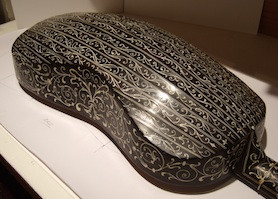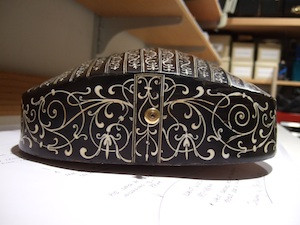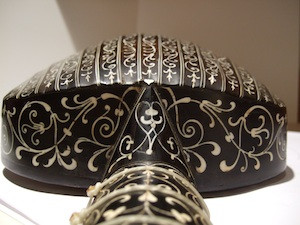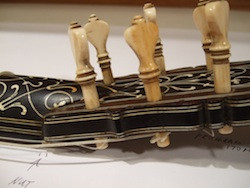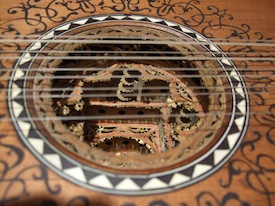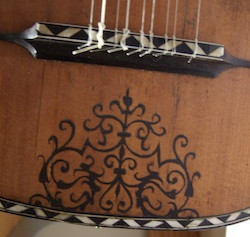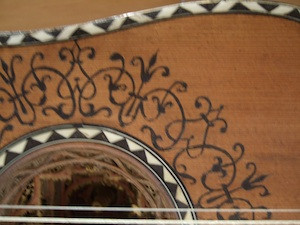This detailed Guitar Drawing unveils the intricate craftsmanship of a 17th-century Jacopo Checchucci guitar, originally from Livorno, Italy, and now housed in the Museum of Fine Arts, Boston. This free PDF download serves as an invaluable resource for luthiers and historical instrument enthusiasts interested in early guitar construction. Measuring 58 cm x 106.5 cm when printed, the full-size guitar drawing provides primary measurements and general details, offering a unique glimpse into the design of this historical instrument. This article delves into the fascinating details captured in the drawing, originally highlighted in a post on April 25, 2012, and now presented for a broader audience seeking insights into historical guitar making.
Delving into the Details of the Checchucci Guitar Back
The guitar’s back is a masterpiece of intricate design, constructed with seventeen deeply fluted ebony ribs. These ribs are lavishly inlaid with ivory arabesques, showcasing the opulent aesthetic of the period. Each ebony rib is separated by a delicate triple spacer of ivory-ebony-ivory, each approximately 2mm wide, adding to the back’s visual complexity. Interestingly, the construction of the back reveals some human imperfections; the rib widths are not consistently uniform across any cross-section. Furthermore, the rib edges show unevenness in several areas, and the central rib exhibits a tilt, noticeable in photographs, where the bass side sits higher than the treble in the deepest part of the back’s curvature.
A detailed view of the 17th-century guitar back showcasing seventeen fluted ebony ribs inlaid with ivory arabesques and triple spacers.
These inconsistencies presented challenges when creating templates for the longitudinal and cross-sectional profiles for the guitar drawing. For the longitudinal profile, the bottom of the flute of the center rib was used as a reference point. The cross-sectional profile in the drawing accurately represents the tilted rib but omits the flutes for clarity.
Examining the Guitar’s Profile and Side Ribs
The side ribs of the Checchucci guitar further exemplify the elaborate artistry of the instrument. They are angled inward from the top, around the entire perimeter of the guitar body. This angle varies between 2 to 4 degrees from a 90-degree perpendicular angle. The most pronounced angle is located at the waist of the guitar, while the angle is smallest at the heel of the neck. The drawing highlights how this smaller angle at the heel may be due to the neck’s upward pull under string tension, causing a slight twist at the front of the body, a detail potentially evidenced by a crease over the front block in the back.
A cross-sectional profile drawing revealing the inward angle of the side ribs and the guitar’s body shape.
A profile drawing of the guitar, highlighting the body’s contours and dimensions based on the central rib flute.
Neck and Peghead Asymmetry: Design or Restoration?
The guitar drawing meticulously captures the neck construction. The neck is glued to the front of the body and further secured with a nail, as evidenced by restoration photographs. A striking detail revealed in the drawing and analysis is the off-center placement of the heel towards the treble side. Compensating for this, the neck is angled back towards the bass side, ensuring the nut aligns with the body’s centerline. This intentional asymmetry, despite significant damage and restoration in this area, is considered original to the guitar’s design. The arabesque ornamentation seamlessly extends from the body to the neck, fingerboard, and both sides of the peghead, maintaining a cohesive aesthetic.
Image showing the neck alignment, highlighting the off-center heel and angled neck to center the nut.
Close-up drawing detail illustrating the triple line border extending from the heel along the guitar neck.
The triple line bordering the heel continues along the neck’s length, with a second triple line subtly present along the fingerboard’s bottom edge. The drawing highlights an area of the neck and soundboard that suffered past damage and underwent incomplete restoration. At the peghead, both triple lines remain intact, framing a veneer of dark wood streaked with brown, offering a pleasing contrast to the black ebony used for the arabesques. The tuning pegs, crafted from ivory, are likely original to the instrument.
Drawing detail of the peghead joint showing intact triple lines and contrasting dark wood veneer.
Peghead Design: A Balance of Elements
The guitar drawing meticulously reveals the peghead’s design, showcasing a balanced arrangement of elements. The front of the peghead features a central panel of black ebony adorned with arabesques, delineated by triple lines of ivory-ebony-ivory, expertly mitered at the corners. A reddish-brown wood field surrounds this central panel, framing the two rows of ivory pegs. This field is further bordered by the same triple lines. The scalloped edge is constructed from solid black ebony, glued to the edges of an unidentified wood forming the peghead’s core. The construction cleverly conceals the two joints of this assembly beneath the outermost triple lines. The peghead’s end is veneered with black ebony, while the exposed core end is painted black.
Detailed drawing of the peghead back, showing the arabesque flow and triple line borders around the reddish-brown veneer.
The rear of the peghead echoes the design motifs of the front but accommodates the V-joint of the neck. Notably, the arabesque pattern flows seamlessly from the curved neck surface onto the peghead’s central panel. The same reddish-brown veneer used on the front’s border is also employed on the rear, covering the peghead’s end. Completing the design, two triple edge lines extend from the peghead’s end, differing from the front design by not being joined by a perpendicular line.
Fingerboard, Rose, and Bridge Details
The fingerboard, crafted from black ebony, continues the ivory arabesque inlay theme. A triple line border of ivory-ebony-ivory, set approximately 4mm from the edge, frames the fingerboard. These lines terminate at the nut, and originally, they likely connected at the soundboard end with a perpendicular triple line and mitered corners. However, due to incomplete restoration, only fragmented remnants of this detail remain.
The drawing also captures the two-headed eagle motif near the rose, rendered in black mastic. This emblem may signify an association of the guitar with the Hapsburg family, a connection suggested by the Museum’s provenance documentation.
Drawing detail of the guitar rose and surrounding area, showing black mastic arabesques and red accents on the gilded parchment.
Black mastic arabesques also adorn the area surrounding the rose and below the bridge. The tiered rose itself is constructed from gilded parchment with red accents. A ring of thirty-two ivory triangles, set in black mastic and bordered by triple lines of ebony-ivory-ebony, completes the rose design.
Drawing of the guitar bridge area, noting the modern replacement bridge and its positioning.
The bridge shown in the drawing is a modern replacement. While the drawing marks the original bridge’s front edge position, it does not include a detailed drawing of the bridge itself. It is believed that the replacement bridge was designed to compensate for restoration-related issues and may not accurately represent historical bridge designs. The current bridge, measuring 15.6mm from front to rear, is likely slightly larger than the original to conceal soundboard damage typically associated with detached bridges. Although centered on the soundboard, the strings are attached off-center towards the treble side, a feature likely intended to compensate for the off-center neck heel and the neck’s bass-ward angle, ensuring proper string alignment over the fingerboard.
Soundboard Border: Saw-tooth Ivory Parallelograms
The soundboard border, as depicted in the guitar drawing, is composed of 104 ivory parallelograms. These are set diagonally in black mastic, creating a distinctive saw-tooth pattern around the soundboard’s perimeter. The outer edge of this design is bound by an ebony/ivory strip, while the inner edge is defined by an ivory/ebony strip.
Drawing detail of the soundboard border, illustrating the saw-tooth pattern created by diagonally set ivory parallelograms.
This free guitar drawing offers a valuable resource for anyone studying historical guitar construction or planning to build a similar instrument. It captures not only the overall form but also the subtle details and construction techniques employed in this remarkable 17th-century guitar.
Download the free PDF Checchucci Guitar Drawing and explore the artistry and craftsmanship of this historical masterpiece.
Acknowledgements:
The author extends gratitude to Darcy Kuronen, Pappalardo Curator of Musical Instruments at the Museum of Fine Arts, Boston, for facilitating the visit, sharing expertise, and providing invaluable insights.
All photographs are credited to the author unless stated otherwise.

